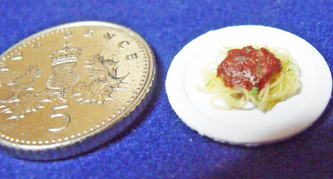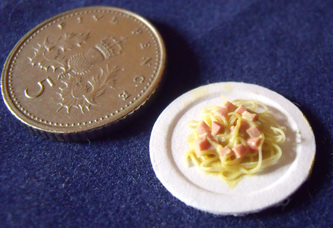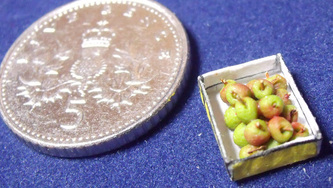There is a considerable body of work done by miniaturists who work with polymer clay. This is given very little prominence yet represents exceptionally skilled work. The main authors in this country are Anglie Scarr and Sue Heaser who have both written a number of books. There is, however, an International Guild of Miniature Artisans who offer recognition of work through awards. Their website is here. And here is the website of a Fellow of the Guild where you can see examples of top quality work.
The British Polymer Clay Guild ( website here) hold bi monthly workshops in Lichfield run by Allan Marshall - details of his remaining workshops this year can be found here and if you are interested in booking he can be contacted on a.f.marshall(at)bpcg.org.uk (substitute the @)
Below are examples of miniature work by Allan who specialises in recreating food. The attention to detail necessary to produce accurate sizing and colouring is quite considerable. More can be found here
The British Polymer Clay Guild ( website here) hold bi monthly workshops in Lichfield run by Allan Marshall - details of his remaining workshops this year can be found here and if you are interested in booking he can be contacted on a.f.marshall(at)bpcg.org.uk (substitute the @)
Below are examples of miniature work by Allan who specialises in recreating food. The attention to detail necessary to produce accurate sizing and colouring is quite considerable. More can be found here
Allan has been venturing into even smaller work. Above is ratio 1/12 work - but he was encouraged to try 1/24 , and then he tried some apples which are 1/48 - but after his attempt told me 'I am not going there!'
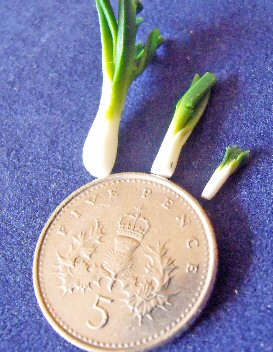
Well- so much for not going there - it is now March 2013 and Allan has chosen to produce a 1/48 piece - so on the left is 1/12, in the middle is 1/24 and on the right is 1/48 - how crazy is that?
Twice yearly you can see a plethera of work by miniaturists at the Miniatura Exhibition.
Below are reviews of a number of books which may be of value, particularly if you are new to miniature work.
Below are reviews of a number of books which may be of value, particularly if you are new to miniature work.
Making Miniature Food and Market Stalls by Angie Scarr (2001)
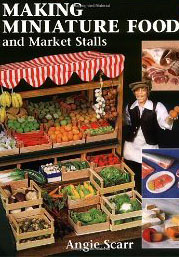
This is Angie's furst book in which you are actually making pieces. This is considered to be an ideal starter book as an introduction to making miniatures. I have it on good authority, however, that you really must be careful with the colour mixing because Staedtler in particular have changed the colours whilst not changing the names of the colours ( red, in particular, is vastly different) However this should not deter you.
Miniature food masterclass - materials and techniques for model-makers by Anglie Scarr (2009)
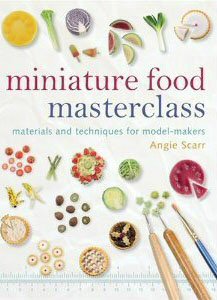
Angie is one of the few miniaturists who has published books - lots of them. Miniaturists do not seem to get much of a 'look in' in the polymer clay world despite there being some talented experts. This book introduces you to the basic techniques - and the canes that can produce quality facsimiles. Her tutorials are clear and the photographs excellent. This is a good follow up to her first book reviewed above.
Food Displays (Dolls House Do-it-YOurself) by Sue Heaser (2003)
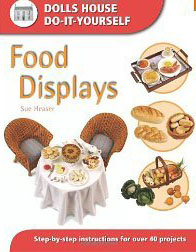
Review by Allan Marshall:
This gives step by step instructions for over 40 projects in miniature food. It contains projects covering things from crockery to various items of food.
The Photos are used showing various stages in producing the items.
Making Miniature Dolls with Polymer Clay: How to Create and Dress Period Dols in 1/12 Scale by Sue Heaser (2001)
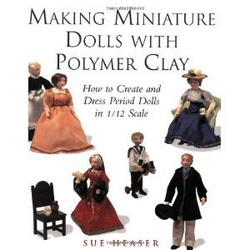
Review by Allan Marshall:
This book goes through the stages of making miniature dolls. Stages are done in drawing form rather than colour photos. It also shows how to use moulds to produce basic facial features. It finishes with dressing and wigging.
Making Doll's House Miniatures with Polymer Clay by Sue Heaser (2000)
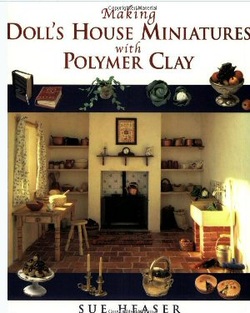
Review by Allan Marshall:
This book covers a multitude of projects, some food, others for houshold items including the kitchen sink. There are some colour pictures of completed items and stages are shown by drawings
